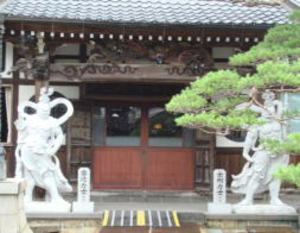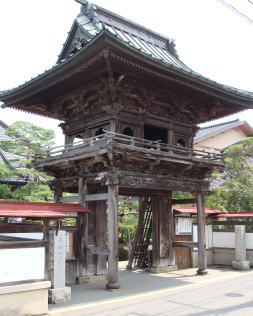An exceptionally prominent gate of the Town Hall's pedestrianized is Komyoji
Romon (Temple Gate or Sanmon , and is precisely the
three-emancipation Gate, Gedatsu in Buddhist circles), it is the Bell Tower
Gate which hung Temple Bell(Bonsho) of the copper banf.
Kansei 9 year (1797 year) during the new Year, the temple gate collapsed
due to heavy snow, and the rebuilding of the Bunka 2 year
(1805 year, Shogunate rejects Russia commerce demands) has become an elaborate construction of the late
Edo period.
Enduring the big shaking of the East Japan big earthquake, the figure that
is standing is
touching sight!
Although
the damage is seen over the course of 200 years, it is now very difficult to gather
the material of such cypress to rebuild.
Aizu Bange town is the only Bell Tower Gate(Shyoromon) and is designated as a tangible cultural property of the town.
Now ! here is the quiz. Several animals are carved in the lower transom. Well, what kind of animals? Turning around the gate and
look around.
Although there is no such splendor as the Youmei-mon gate of Nikko Toshyogu
Shrine in Nikko City, Tochigi Prefecture, it is a
cultural asset of the town which can feel the breath of culture of Edo
period.
The photo
is the Hockai-Ji temple Romon(temple gate)
It is located in just behind of
the town hall. Genki 2 year(the year in which 1571 year, Nobunaga Oda burned the Enryaku-ji temple
of Mt.Hiei) was founded. Owa 4 year (964 year, Heian period, from
this time Mr. Fujiwara’s regency government begins) when the
Kuya-Shonin was on tour to preach in Aizu Fuyukizawa Hachiyou-ji temple founded(Kawahigashi town,
Aizu Wakamatsu city) was
created (from Aizu-kuji-zacko).Shining in western place here built a Soan, the Dojo the prayer to the Buddha called Komyo-an.
Tensho 3 year(1575 year, Nobunaga Oda and Ieyasu Tokugawa's Allied army was defeats
Katsuyori Takeda in the Battle of
Nagashino)
a monk Gyugan from Boso(Chiba Prefecture)lives n
the Komyo-in in Bange village of Inagawa-sho and renews the
Komyo-in to the Komyo-ji temple(from Shin-pen-Aizu-fudoki). The main hall is the architecture of Enkyo 3 year (1746 year, the most
later years of Yoshimune Tokugawa).
Bunka 1 year (1804 year, when Napoleon became emperor) in reconstructed . Kansei 9
year(1797 year) The Sanmon (Temple Gate)
collapsed due to heavy snowfall at the New Year, Bunka 2 year (1805 year, Shogunate rejects Russia commerce demands) at
reconstruction, The Romon (Four-pillar Gate) of the masterpiece of the late Edo is
get a lot of looks.
The principal image is wooden statue of Amida-Nyorai of Azuchi-Momoyama period.
Two Attendants statue, Kannon and Seishi-Bosatsu. Other, statue of Founder of a religious of Zendo-Daishi and Honen-Shonin
are
enshrined. A richly colored pattern is drawn on the ceiling, the colmun, and Raigo-wall of in main hall chancel, and in a horizontal
piece of timber is enshrined in the thousands of Buddhist images, which was dedicated to the middle of Edo period and has 800
bodies. In the Gejin the Jyuo statue
is enshrined, and both the inside and outside,
the interior is heavily represent the early modern
Jyodo style.
The Juo Buddha is the one to been shrined by building the Jyuo Hall separately if it is original, and dismantling because the rot of
the Hall
at the beginning of the Taisho period became violent, and moved the Juo Buddha to the main hall.
Reminiscent of the Jyodo faith of in the early modern, the Main Hall is enough well worth seeing. Prior permission is necessary for
the visit in the main hall..
The world-famous woodblock print artist, graveyard of Kiyoshi Saitou and his wife.
Location: Chaya-machi, Aizu Bange town
Prior permission is necessary for the visit in the main hall.
Please contact the Aizu Bange town Tourism Product Association (℡ 0242-83-2111) in advance.
(Welcome
map Aizu Bange town Central area map)
Jodo-Shu Shokakuzan Komyo-ji temple
Enshrined on the left immediately after entering
the temple gate, a small but respectable shrine called "Kotaki Inari
shrine ".
It was originally a residence god of the Kotaki house (Kotaki store of Hashimoto's autonomy Association), by the telling of the dream
of one day,transfer to the Honjin (around Town Hall Building), in addition it was
said that relocation of a shrine to the
Komyo-ji.
When child is troubled by cry in the night, make a pilgrimage to this Inari,
it is said that it stops crying, miracle have been
miraculous and faith for a long time.
Mothers and fathers of trouble in the cry of the child, how about you try
to rely the Komyoji Inari once?
Breath of Edo culture, Komyo-ji Temple Romon(temple gate)
A family ally in raising children
Kotaki Inari Shrine



